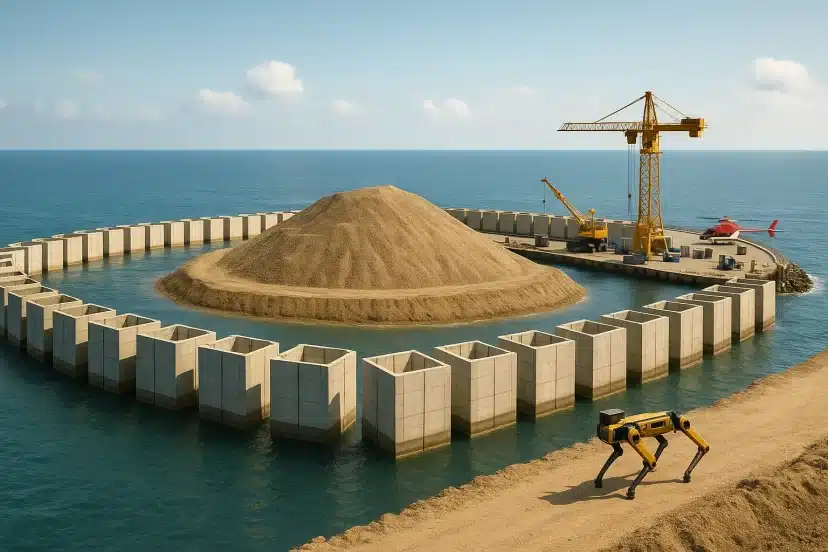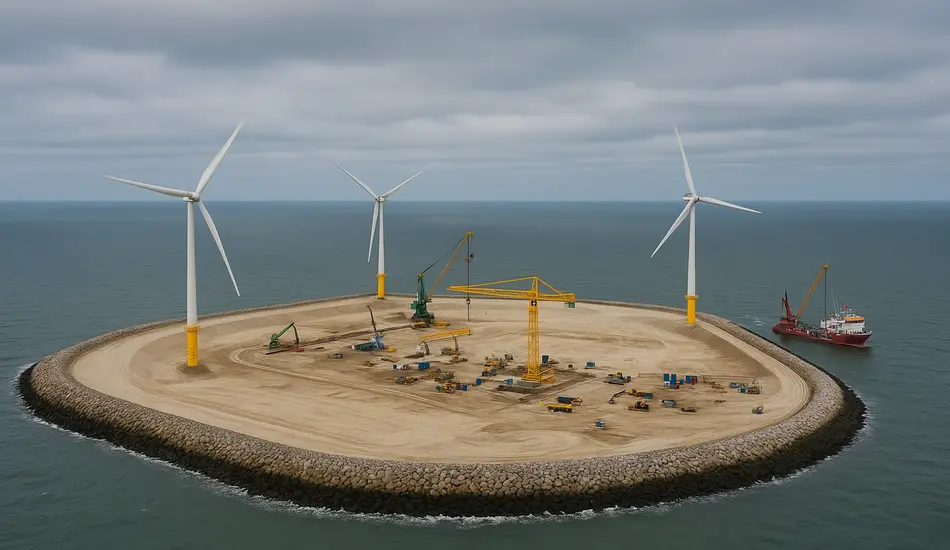Belgium Artificial Energy Island, the world’s first project of its kind, has begun construction to collect power from massive offshore wind farms in the North Sea and distribute it across Europe. Known as Princess Elizabeth Energy Island, the project is seen as a centerpiece of Europe’s green transition and energy independence plans.
Located 45 kilometers offshore, the island will not host residents but will serve as a hub for wind-generated electricity, transmitting power to Belgium and neighboring countries. Its strategic role became even more critical after Russia’s invasion of Ukraine in 2022, which sharply reduced Europe’s access to natural gas and accelerated the continent’s push toward renewable energy.
Belgium Artificial Energy Island: An Ambitious Energy Grid Vision
Belgium already ranks seventh worldwide in offshore wind power, with eight operational wind farms. The new Belgium Artificial Energy island will anchor three more wind farms in the Princess Elizabeth Zone, expected to deliver 3.5 gigawatts of electricity—enough to supply millions of homes.
The island is also part of a larger plan: a North Sea wind power grid, where energy hubs link multiple countries. High-capacity cables, such as Nautilus (to the UK) and Triton Link (to Denmark), would allow countries to trade renewable energy depending on supply and demand.
“The North Sea is set to become the powerhouse of our energy independence,” said former Belgian Prime Minister Alexander De Croo, highlighting the project’s geopolitical significance.
Engineering a Man-Made Island
Belgium has no natural islands, making artificial construction the only option. The foundation relies on 23 giant concrete caissons, each weighing up to 22,000 tons, anchored to the seabed. Once in place, they are filled with sand and reinforced to create the island’s perimeter.
The core will hold 3 million cubic meters of compacted sand, stabilized with a process called vibroflotation. By 2028, the island is expected to cover six hectares, complete with a harbor and helipad. When staff are absent, robot dogs will patrol the site to conduct inspections and transmit images to the mainland.

Environmental Concerns
Developers have promoted a nature-inclusive design, incorporating artificial reefs, oyster beds, and bird ledges to support marine biodiversity. The project also uses ultra-low carbon cement to cut emissions by 40%.
Still, environmental groups remain cautious, warning that the long-term impact on fisheries and sea life is uncertain.
Spiraling Costs and Delays
Despite the engineering progress, the project is under financial strain. Initially budgeted at €2.5 billion in 2021, costs have ballooned to over €8 billion. A shortage of suppliers for direct current (DC) substations—crucial for long-distance electricity transmission—has further strained the project.
In January 2025, energy buyers urged a halt to construction, citing soaring prices. By June 2025, developers officially cancelled the DC component, delaying the project’s ability to function as a transnational hub.
The island’s original launch date of 2030 has now slipped to at least 2032, and further postponements remain likely.
Hire Talent to Navigate Complex Energy Projects
Post your job on WhatJobs and connect with engineers, project managers, and energy experts—those who can keep high-stakes infrastructure on cost and on time.
Post a Job Now →A Broader European Struggle
Belgium is not alone in facing setbacks. Denmark recently delayed its own energy island plans to at least 2036 and announced a review of wind energy financing earlier this year.
As Europe races to meet its climate goals, the fate of the North Sea wind grid hangs in the balance. Belgium’s Princess Elizabeth Island remains a bold experiment—but whether it becomes the future of European energy or a cautionary tale of overreach is still uncertain.
FAQs: Princess Elizabeth Energy Island
1. What is the purpose of Belgium’s energy island?
The island will serve as a hub to collect power from offshore wind farms, convert it into direct current (DC) for long-distance transmission, and distribute it to Belgium and other European countries.
2. Why is it important for Europe’s energy future?
The project is part of a wider North Sea energy grid that aims to reduce reliance on fossil fuels, strengthen energy independence after Russia’s invasion of Ukraine, and meet EU carbon reduction targets.
3. Why has the project become so expensive?
Costs have surged from €2.5 billion to over €8 billion, largely due to supply chain shortages and rising prices for DC substation equipment, which is essential for transmitting electricity over long distances.
4. When will the energy island be completed?
The island’s structural completion is expected by 2028, but the energy transmission systems are now delayed until at least 2032—if not longer—after the DC component was cancelled.




